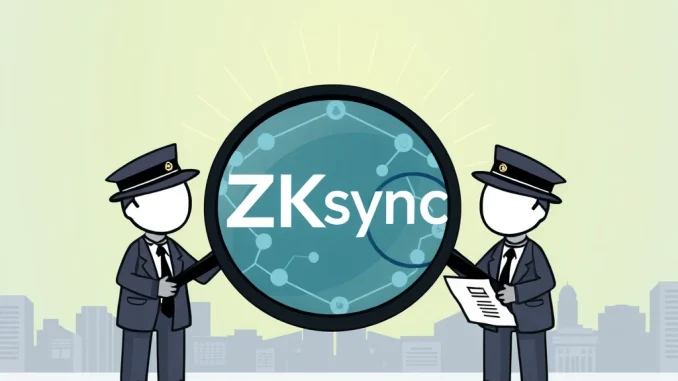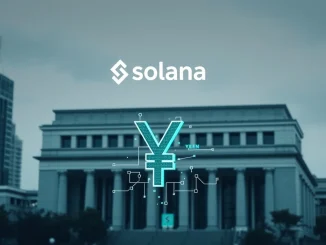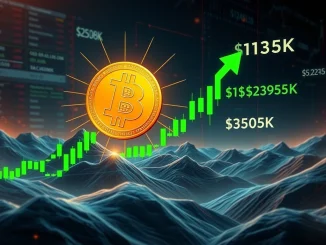
The world of Ethereum scaling just got hit with some serious news. ZKsync, a prominent player in the Layer 2 space utilizing zkEVM technology, has confirmed it’s under the microscope of U.S. authorities. This isn’t just a minor check-up; we’re talking about investigations by heavy hitters like the Department of the Treasury and the Securities and Exchange Commission (SEC). For anyone involved in crypto, particularly within the Ethereum ecosystem, understanding this ZKsync SEC investigation is critical.
ZKsync SEC Investigation: What Are the Core Concerns?
According to a statement from ZKsync itself, the investigations stem from concerns primarily related to zkEVM-based applications within its ecosystem that are accessible to users in the United States. The specific areas of focus are serious and multi-faceted:
- Potential violations of U.S. securities laws.
- Compliance with Anti-Money Laundering (AML) and Know Your Customer (KYC) regulations.
- Possible instances of sanctions evasion.
These are standard, yet significant, areas of regulatory focus in the digital asset space. The SEC typically scrutinizes whether certain tokens or activities constitute unregistered securities offerings, while the Treasury Department is deeply concerned with preventing illicit finance and ensuring compliance with sanctions programs.
Navigating Crypto Regulations US: Why Layer 2s Are Under Scrutiny
The fact that a Layer 2 protocol like ZKsync is facing this level of scrutiny highlights the expanding reach of crypto regulations US authorities are enforcing. Historically, much of the regulatory focus was on centralized exchanges and initial coin offerings (ICOs) on Layer 1s like Ethereum. However, as activity, liquidity, and innovation move to Layer 2 solutions designed to scale Ethereum, regulators are following.
The accessibility of zkEVM applications to U.S. persons appears to be a key trigger here. U.S. regulators assert jurisdiction over activities impacting U.S. citizens or markets, regardless of where the underlying technology is based. This puts the onus on decentralized protocols and platforms to consider their global user base and potential exposure to different regulatory regimes.
zkEVM Compliance Challenges: What ZKsync Must Address
Building a high-performance scaling solution like a zkEVM involves complex technical and economic design choices. Ensuring zkEVM compliance with diverse and sometimes ambiguous regulations adds another layer of difficulty. For ZKsync, addressing the current probes will likely involve demonstrating:
- How it determines user location and restricts access where necessary.
- What measures are in place (or can be implemented) to prevent illicit activities and comply with AML/KYC principles, even in a decentralized context.
- That its technology or associated assets do not fall under the definition of a security under U.S. law.
This is a significant undertaking, requiring deep technical understanding combined with sophisticated legal analysis. ZKsync has stated it is working with external legal experts to navigate these challenges, which is a standard and prudent step in such situations.
The Treasury Crypto Probe: More Than Just Securities Laws?
While the SEC often grabs headlines for its focus on securities, the Treasury crypto probe brings concerns about financial crime and sanctions to the forefront. The Treasury Department, particularly through its Financial Crimes Enforcement Network (FinCEN) and Office of Foreign Assets Control (OFAC), is keen to ensure that cryptocurrency is not used to circumvent financial regulations or sanctions.
The investigation by Treasury suggests that authorities may be looking into how transactions or activities facilitated by the ZKsync network could potentially be exploited for money laundering or by sanctioned entities. This broadens the scope beyond just the nature of the ZKsync token or specific dApps to the overall flow of funds and user identification within the ecosystem.
Ensuring Ethereum Layer 2 Compliance: Steps Forward
This situation with ZKsync serves as a stark reminder for all Ethereum layer 2 compliance efforts. As Layer 2s become more integrated into the global financial infrastructure, the expectation for them to adhere to traditional financial regulations, adapted for the digital age, will likely increase. This could lead to:
- Increased focus on decentralized identity solutions.
- Development of compliance tools compatible with Layer 2 architectures.
- More explicit risk assessment and mitigation strategies for protocols operating globally.
The industry is still grappling with how to reconcile the principles of decentralization and privacy with regulatory demands for transparency and control. ZKsync’s experience may help shape future approaches and clarify regulatory expectations for similar technologies.
Contextualizing the News: The Recent Security Incident
Adding a layer of complexity, this announcement follows a brief security incident where ZKsync’s official X account was compromised. Reports indicate the account was used to promote a fraudulent ZK token airdrop, though the malicious post was removed relatively quickly. While seemingly unrelated to the regulatory probes themselves, such incidents can unfortunately add to a narrative of potential risk or control issues from a regulator’s perspective, even if the compromise was external.
Summary: A Critical Juncture for ZKsync and Layer 2s
The investigations by the U.S. Treasury and SEC represent a critical challenge for ZKsync. They highlight the growing focus of regulators on the Ethereum Layer 2 ecosystem and the complex issues surrounding securities laws, AML/KYC, and sanctions compliance in a decentralized context. ZKsync is engaging legal expertise to address these concerns, a process that will be closely watched by the entire industry. The outcome of these probes will not only impact ZKsync but could also set important precedents for how other zkEVMs and Ethereum scaling solutions navigate the evolving landscape of crypto regulations US.
This situation underscores the ongoing tension between innovation in decentralized finance and the need for regulatory frameworks to protect consumers and prevent illicit activity. It’s a dynamic space, and staying informed is key.



